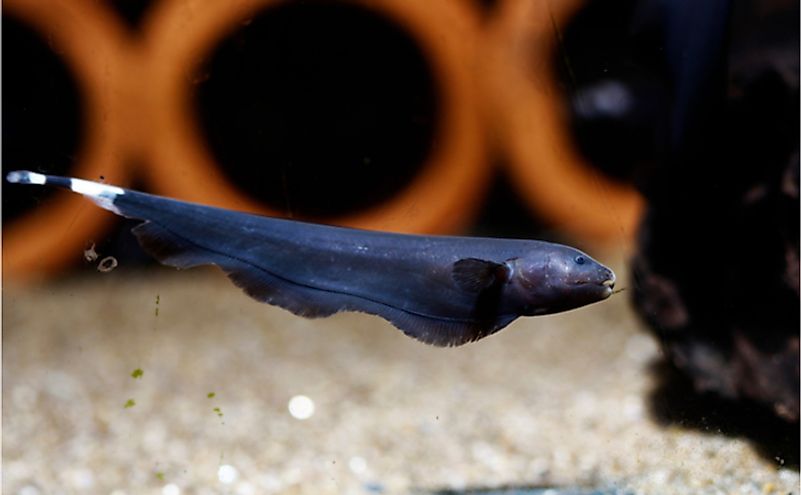Animals That Produce Deadly Electricity

The electrophysiological phenomenon of electricity generation in living organisms is called bioelectrogenesis. Although plant cells exhibit light-induced electrogenesis and some microbial cells are also capable of generating electric currents, here we will discuss the electrogenic properties of larger vertebrate species, especially several aquatic creatures that can produce electricity strong enough to stun an adult human being. Biolectrogenesis is utilized by these creatures for hunting prey, self-defense, electrocommunication, and/or electrolocation purposes.
5. Black Ghost Knifefish

The black ghost knifefish (Apteronotus albifrons) inhabits the freshwater habitats of tropical waters in South America including the Amazon basin. The fish is named so for its all-black color except for a white blaze on the nose and two white rings on the tail. The fish is scale-less and grows to attain a maximum length of about 50 cm. The black ghost knifefish is also nocturnal and weakly electric. It possesses an electric organ, and electro-receptors are distributed all over its body. Thus, it is among the few animals that can both produce and sense electricity. The fish uses its electrogenic and electrosensing capabilities to locate insect larvae, its primary food. The fish generates electric signals called electric organ discharges (EOD’s) using the electric organ. The EOD’s are picked up by the electrosensing receptors present on the body of the fish. The fish use these electrical properties to communicate with each other and also for electrolocation.
4. Electric Rays

The electric rays are cartilaginous fishes comprising the order Torpediniformes. There are about 69 species of these rays. The most distinguishing feature of these fish is their ability to produce electric discharges that are used to stun their prey or as a mechanism of defense. The rays are capable of producing electric discharges ranging from 8 to 220 volts. The best-known members of the electric rays are those belonging to the Torpedo genus.
The electric rays inhabit shallow coastal waters up to a depth of at least 3,000 feet. They are slow-moving creatures that use their tails to propel themselves forward instead of their pectoral fins. These rays feed on small fish and vertebrates and use electricity generated by them to stun and capture the prey. The electric rays have been known for their electrogenic properties since antiquity. The ancient Greeks would use the electricity generated by these rays to numb pain caused during surgeries and childbirth. As per the accounts of an ancient Roman physician, the electrical properties of the torpedo fish were used for treating gout and headaches. It has also often been associated with mystical powers due to its ability to stun people without touching them.
3. Northern Stargazer

The northern stargazer (Astroscopus guttatus) is a fish that can be found on the eastern shores of the United States between New York and North Carolina. The fish can be found at depths of up to 120 feet. The blackish-brown body of the northern stargazer has white spots on the neck and back. It has a mouth that faces upwards which allows it to ambush prey while it remains well camouflaged in the sandy bottoms of the coastal waters. The northern stargazer is also able to generate electricity due to the presence of electric organs in the orbitae. The electric shock generated by the fish is used in hunting for prey and in self-defense.
2. Electric Catfish
The electric catfish are catfish of the family Malapteruridae, that has two genera and 19 species. Many of the species of this family are capable of generating electric shocks of up to 350 volts, hence the name. The electric catfish are found in the tropical regions of Africa and the Nile River. They are nocturnal and carnivorous. They feed on other fishes, fish eggs, detritus, and invertebrates with the food habit varying by species. The electric catfish use electric shock as a means to stun their prey. The electric catfish is the only catfish group that has electrogenic organs that are well-developed. Interestingly, ancient Egyptians would utilize the electric shock generating the ability of the electric catfish to treat arthritis pain. For this purpose, only small-sized fishes were used since the larger ones are capable of generating painful shocks. Mural paintings of ancient Egypt depicting these fish are thus common. Even an account of a 12th-century Arab physician mentions the electric properties of the electric catfish. Although the shock generated by the electric catfish are not known to be fatal to humans, large individuals are capable of stunning an adult human with an electric shock.
1. Electric Eel
The electric eel (Electrophorus electricus) is the only species in the Electrophorusgenus and is known for its ability to produce electricity. The fish live in the Amazon and Orinoco freshwater river basins in South America. Despite its name, the electric eel is not a true eel but a knifefish. The electric eel has an elongated scale-less cylindrical body with a dark gray-brown dorsal surface and yellow or orange undersides. It has a square mouth at the end of the snout.
The most interesting feature of the electric eel is the three pairs of abdominal organs that generate electricity. These are known as the main organ, Sach’s organ, and Hunter’s organ. Four-fifths of the body of the eel is occupied by these organs. With the help of these organs, the fish can generate both high and low voltage electricity. The electric organs are made of electrolytes and arranged in a manner that adds to a potential difference and allows a current of ions to flow.
The electric producing capacity of the electric eel is usually utilized to stun the prey of the species. Once the eel detects its prey, the brain transmits a signal via the nervous system to the electric organs. Ion channels are opened which allows the flow of sodium ions resulting in a momentary reversal of polarity. This generates a sudden potential difference and electric current.
Although the electricity produced by an electric eel is only momentary and unlikely to prove fatal to humans due to the short duration of the discharge, human deaths have been known to occur. The electric current generated by the electric eel will produce a painful and numbing shock to those exposed to it. Aquarium caretakers and biologists handling these eels are thus advised to be extra cautious.











